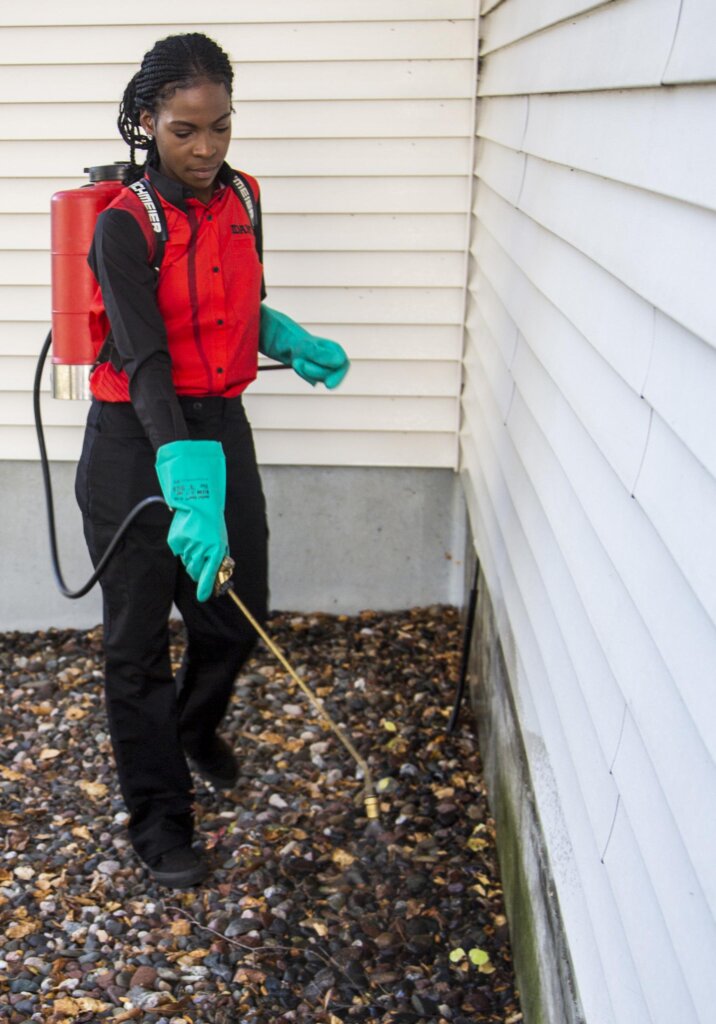Relied On A1 Exterminator Charlotte NC - Comprehensive Pest Solutions
Relied On A1 Exterminator Charlotte NC - Comprehensive Pest Solutions
Blog Article
Bed Bug Treatment Malfunction: Contrasting Chemical Vs. Non-Chemical Solutions
In the realm of pest control, especially when handling the relentless concern of bed insects, the option in between chemical and non-chemical therapy services can be a critical one. Both approaches offer distinctive benefits and downsides, affecting aspects such as effectiveness, safety and security factors to consider, and overall cost. By analyzing the nuanced information of each approach, a more clear understanding of which course to seek in addressing a bed bug invasion can be attained.
Efficiency of Chemical Therapies
Chemical treatments for bed insect infestations have been commonly recognized for their quick and potent efficiency in getting rid of these bugs. When considering the effectiveness of chemical therapies, it is vital to comprehend that they can provide a detailed and quick remedy to a bed pest issue.
Moreover, chemical treatments have the advantage of providing recurring effects, implying that they can proceed to get rid of bed insects also after the preliminary application. This residual activity is particularly beneficial in combating any kind of potential re-infestations. In addition, the fast activity of chemical treatments can bring relief to individuals dealing with extreme bed bug invasions, permitting them to restore control of their home swiftly.
Security Worry About Chemical Solutions
One vital element that calls for cautious consideration when making use of chemical services for bed pest treatment is guaranteeing the safety and security of passengers and the atmosphere. Exposure to certain chemicals made use of in bed pest therapies can lead to respiratory system concerns, skin irritability, or various other adverse reactions, specifically in individuals with pre-existing conditions or level of sensitivities.
In addition, the environmental effect of chemical solutions is another substantial factor to consider. Some pesticides used in bed pest treatments may be harmful to valuable bugs, wild animals, and ecosystems if they leach into the dirt or water supply. It is necessary to utilize chemical treatments sensibly, complying with security guidelines, and thinking about much less toxic alternatives to reduce these risks and make certain the secure and efficient monitoring of bed insect problems.
Benefits of Non-Chemical Methods
Considering the potential safety issues and environmental effect linked with chemical services for bed pest treatment, exploring non-chemical approaches presents a promising alternative with several distinctive benefits. Non-chemical therapies are ecologically pleasant, as they do not contribute to air or water contamination, making them a lasting selection for bug control.
In addition, non-chemical services can be reliable in official website targeting bed insects, consisting of hard-to-reach areas where chemical therapies may not permeate - A1 bed bug exterminator charlotte. Methods such as warm therapy, vacuuming, steam cleansing, and cushion encasements supply complete eradication without the use of hazardous chemicals.
Limitations of Non-Chemical Treatments

Furthermore, non-chemical treatments typically need multiple applications to accomplish effective removal. This can be taxing and might not always ensure total removal of all bed pests and their eggs, particularly in surprise or hard-to-reach locations.
Additionally, the success of non-chemical therapies greatly counts on proper application and thoroughness, which can be challenging for individuals without expert knowledge. Insufficient application of non-chemical approaches might cause insufficient eradication, leading to persistent infestations and the requirement for extra treatments.
As a result, while non-chemical therapies have their benefits, it is vital to recognize these constraints and consider them when figuring out one of the most effective approach for managing bed pest problems.
Expense Comparison: Chemical Vs. Non-Chemical Options
Given the limitations related to non-chemical therapies, an essential aspect to evaluate in the context of bed pest monitoring is the expense comparison between chemical and non-chemical options. Chemical therapies typically involve the application of pesticides by experts, which can range from $250 to $900 per see this website room, depending on the severity of the problem and the dimension of the area to be treated. In contrast, non-chemical therapies like warm therapy or vapor can be a lot more pricey, with prices varying from $1,000 to $6,000 for click here to find out more a whole home. While the initial expense of chemical treatments might appear reduced, several therapies may be required to totally eliminate the infestation, possibly enhancing the overall price. On the other hand, non-chemical choices might supply a much more lasting and environmentally friendly service, although they can be cost-prohibitive for some people. Ultimately, when thinking about the expense of bed insect therapy options, it is very important to weigh the ahead of time costs versus the efficiency and lasting sustainability of the chosen approach.
Final Thought

Thinking about the prospective security issues and ecological impact connected with chemical remedies for bed pest treatment, checking out non-chemical strategies presents an appealing option with numerous distinct benefits.Offered the constraints associated with non-chemical therapies, a crucial facet to assess in the context of bed bug management is the cost contrast in between chemical and non-chemical alternatives. In comparison, non-chemical treatments like warmth treatment or vapor can be much more expensive, with expenses ranging from $1,000 to $6,000 for an entire home. While the first expense of chemical treatments may seem lower, multiple treatments may be needed to fully remove the problem, possibly increasing the general cost.In conclusion, when contrasting chemical and non-chemical bed pest therapy options, it is necessary to consider performance, safety, benefits, limitations, and expense.
Report this page